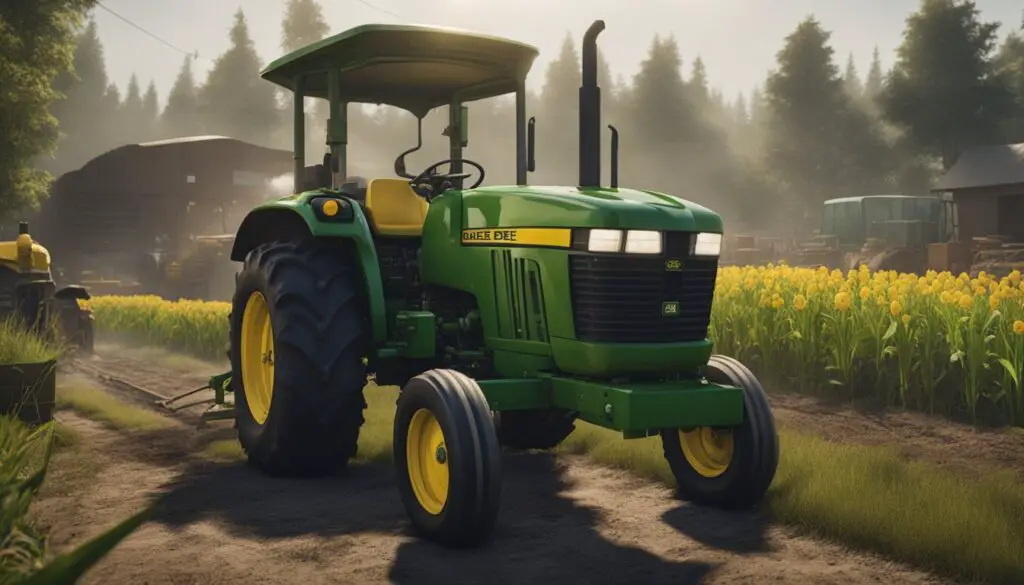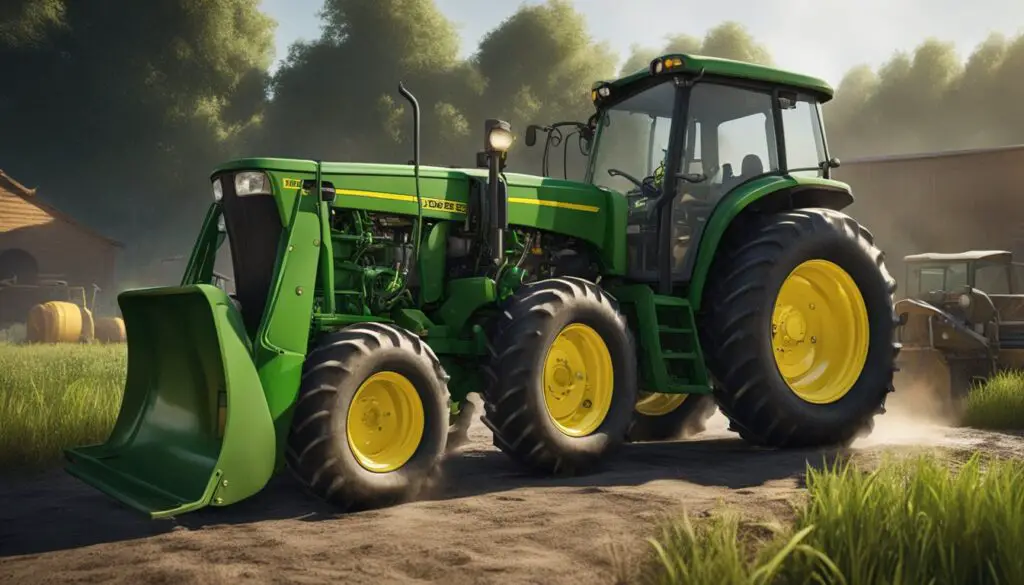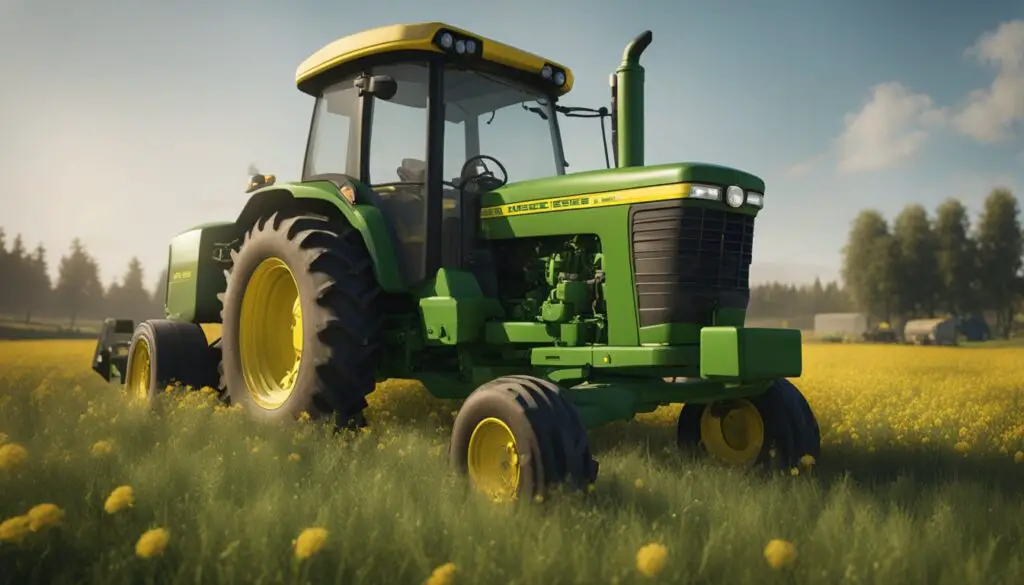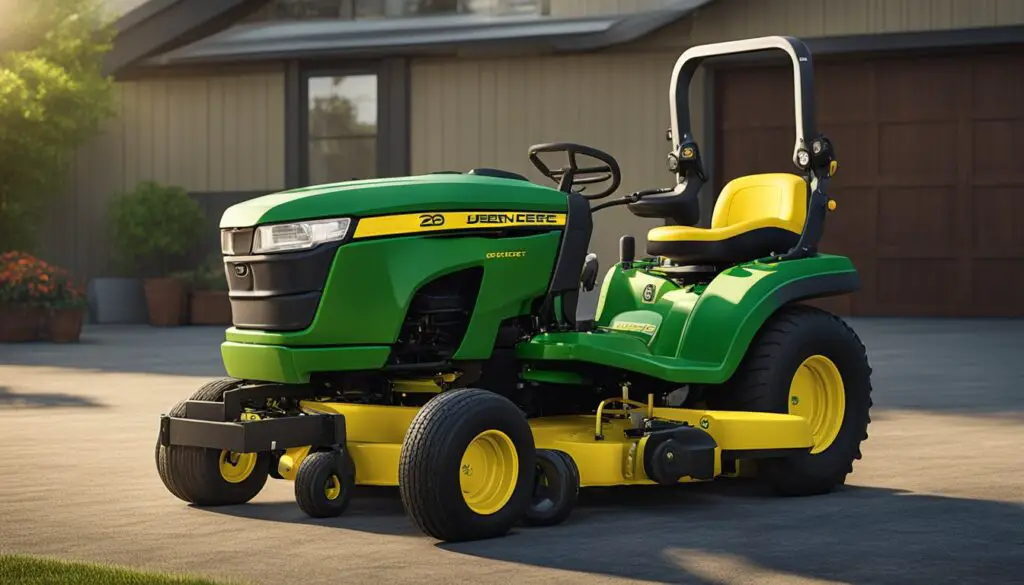The John Deere 2305 is a compact utility tractor known for its versatility and ability to handle a multitude of tasks on a farm or property. Despite its smaller size, it comes equipped with a strong 24hp engine and a reliable hydrostatic transmission, making it a favorite among those with smaller acreage or particular demands. Nonetheless, like any mechanical equipment, the 2305 is not without its issues. It is essential for owners to recognize these potential problems to maintain the tractor’s performance and extend its service life.

Knowing how to troubleshoot and address the common problems can save you time and money. The tractor’s reliability largely hinges on the well-being of key components such as the engine, hydraulic system, electrical system, and power take-off (PTO). Issues in these areas may manifest as stalling, leaks, electrical malfunctions, or PTO failures. Regular maintenance and timely repairs are crucial in preventing disruptions during crucial work times. Enhancements and adjustments can further refine the tractor’s operation, tailoring it to specific tasks and ensuring smoother performance.
Key Takeaways
- Recognizing issues with critical components is essential for maintaining your John Deere 2305.
- Regular maintenance prevents common problems and keeps performance steady.
- Timely repairs and adjustments enhance the tractor’s functionality and longevity.
Understanding Your John Deere 2305
Your John Deere 2305 compact utility tractor is a versatile machine known for its robustness and variety of attachments. Ensuring you’re familiar with its features and maintenance needs is key to keeping it running smoothly for years to come.
Key Features & Attachments
- Horsepower: 24hp engine for effective power delivery.
- Transmission: Hydrostatic transmission ensures smooth operation.
Available Attachments:
- Front Loader: For material handling.
- Mower Deck: Provides a clean and even cut for your lawn.
- Backhoe: Ideal for digging and excavation tasks.
By utilizing the specific attachments designed for your tractor, you can maximize its utility and tailor it to the tasks at hand.
Maintenance Schedule & Service Manual
Regular Maintenance Intervals:
- Every 50 hours: Check engine oil level and cleanliness.
- Every 200 hours: Replace fuel and air filters.
- Annually: Change engine oil and filter, replace hydraulic filters.
Service Manual Access:
A detailed service manual is essential. You can typically find this document online via John Deere’s website or through an authorized dealership.
Manual Highlights:
- Step-by-step guides for routine service procedures.
- Diagnostic information for troubleshooting common issues.
- Parts lists for reference and replacement.
Adhering to the maintenance schedule outlined in your service manual is crucial to the longevity and performance of your tractor. It’s your go-to resource for keeping your John Deere 2305 in top condition.
Common Engine Problems
When your John Deere 2305 starts acting up, it’s often related to the engine. You might encounter issues like stalling, difficulty starting, or less than optimal performance. Let’s address some solutions to these frustrating problems.
Engine Stalling and Starting Issues
If your tractor is stalling or having trouble starting, there are a couple of things to check. First, make sure your engine is receiving adequate fuel. A clogged fuel filter is a common culprit here. Also, check your fuel lines for any signs of blockage or leaks. It’s important to keep an eye on:
- Fuel filter condition: Replace if clogged or dirty.
- Fuel line integrity: Look for damage or leaks and repair if necessary.
Spark Plug and Air Filter Concerns
Your engine’s performance heavily depends on spark plugs and air filters. A dirty or faulty spark plug can cause your engine to misfire or run erratically. Similarly, a clogged air filter restricts airflow to the engine, hampering its efficiency. To keep these components in check:
- Spark Plug: Inspect for corrosion or buildup and replace if needed.
- Air Filter: Clean regularly and replace if it’s worn out or damaged.
Fuel System and Injection Nozzles
The fuel system and injection nozzles deliver fuel to the engine with precision. However, poor maintenance can lead to issues like clogged injection nozzles, which result in improper fuel spray patterns and engine performance problems. To avoid this:
- Clean or replace clogged injection nozzles routinely.
- Regular service: Keep up with regular maintenance to prevent fuel system issues.
Each of these components plays a vital role in the seamless operation of your John Deere 2305’s engine. By staying on top of maintenance and being aware of these common issues, you can ensure your engine runs smoothly for all your tasks.
Hydraulic System Troubleshooting

When addressing the hydraulic system of your John Deere 2305, it’s crucial to effectively identify issues, maintain fluid and cylinder health, and tackle any leaks or pressure complications you come across.
Identifying Hydraulic Problems
To pinpoint hydraulic issues, observe your tractor’s performance closely. If you experience weak or slow responses from hydraulic implements, it may indicate a problem. Hydraulic problems often manifest as difficulty in lifting or lowering attachments or an unsteady operation of hydraulic components.
Checking Fluid and Cylinder Health
Always monitor the fluid level; insufficient hydraulic fluid is a frequent troublemaker. Here is how you can check it:
- Locate the dipstick or sight glass on your hydraulic fluid reservoir.
- Ensure that the fluid is at the recommended level and the quality is not compromised. Contaminated or old fluid could harm the system.
- Inspect the hydraulic cylinder for signs of wear or damage; scratches or dents can impair functionality.
Dealing with Leaks and Pressure Issues
Leaks within the hydraulic system can lead to loss of pressure and affect performance. Here’s a quick guide for addressing these issues:
- Identify any leaks by visually checking hoses, fittings, and seals for wetness or drips.
- Confirm that the hydraulic fluid is at the appropriate level and topped up if necessary.
- Ensure that the relief valve is working properly, as it is an essential component for maintaining the correct hydraulic pressure. If you suspect a faulty valve, consult your tractor’s manual or a professional for replacement steps.
Remember to handle hydraulic fluid and system components with care to maintain the proper functioning of your John Deere 2305’s hydraulic system.
Hydrostatic Transmission Insights

Your John Deere 2305’s smooth operation heavily relies on maintaining its hydrostatic transmission. This section will guide you through proper fluid and filter management and explain how to address common hydrostatic transmission issues.
Transmission Fluid and Filter Management
Keeping your transmission fluid at the optimal level and ensuring filters are not clogged are fundamental for the health of your tractor’s hydrostatic transmission. Here are some specific steps you should take:
- Check the transmission fluid level regularly. The sight glass or dipstick on your tractor will indicate whether you need to top up.
- Change the transmission fluid according to the manufacturer’s recommendation. This usually involves draining the old fluid and filling it with fresh fluid.
- Replace or clean filters as part of regular maintenance to prevent debris from clogging. This ensures fluid flows freely, reducing the risk of transmission problems.
Solving Hydrostatic Transmission Issues
When you encounter hydrostatic transmission issues, here’s how you can approach them:
- Identify Symptoms: Watch out for signs like transmission slipping, slow response, or complete lack of movement.
- Troubleshoot:
- Low transmission fluid level: Add fluid to the appropriate level.
- Dirty or clogged filters: Replace the filters to ensure clean fluid is circulating.
- Seek Expert Advice: If basic troubleshooting doesn’t resolve the issues, consult a professional. Complex internal wear or damage may require professional service.
Electrical System Checklist

When maintaining your John Deere 2305, keeping a keen eye on the electrical system is crucial. This includes ensuring a well-maintained battery and addressing any potential electrical problems that can affect your tractor’s performance.
Battery and Connection Maintenance
First things first, check your battery and its connections. A weak or uncharged battery can lead to a host of electrical issues, from starter problems to non-functional lights.
- Ensure your battery terminals are free of corrosion. Clean them if necessary.
- Test the battery’s voltage to verify it holds a proper charge. If it’s weak, charge the battery.
- Inspect all battery connections for tightness; loose connections can prevent your tractor from starting.
Addressing Electrical Problems
Next, if you’re encountering electrical issues, here’s how to proceed:
- Look for any blown fuses and replace them. A blown fuse can interrupt the electrical flow to essential systems.
- If your tractor’s lights or gauges act erratically, or the starter fails to turn over, suspect loose electrical connections or a faulty starter.
- Tighten all connections and test the starter, replacing it if it fails to operate after ensuring the battery is adequately charged.
Remember, a systematic approach will save you time and prevent further issues with your John Deere 2305’s electrical system.
PTO and Mower Deck Adjustments

When dealing with your John Deere 2305, understanding proper PTO clutch and shaft operations, as well as ensuring your mower deck performs optimally, are key to maintaining your tractor’s longevity and efficiency.
PTO Clutch and Shaft Operations
Your PTO (Power Take-Off) clutch is crucial for transferring power to the attachments like the mower deck. A common problem you might face is with the PTO clutch not engaging or disengaging properly. This could be due to a malfunctioning electrical switch or a PTO clutch that is worn out and requires replacement. To check for issues:
- Inspect the PTO switch for functionality.
- Ensure the wiring is intact, with no frays or breaks.
- Examine the PTO clutch for wear and tear, looking for signs like burn marks or unusual noise.
The PTO shaft, which spins to transfer the power, could also be a source of trouble. A frequent symptom is a failure in PTO shaft which could cause further damage to the transmission housing if not addressed promptly. It’s imperative to:
- Regularly lubricate the PTO shaft to avoid this issue.
- Check for physical damage or wear, replacing the shaft if necessary.
Mower Deck Performance
For the mower deck, consistent and even cuts are your goal. Problems may arise in the form of uneven cuts or a damaged or worn blade. Here’s how to adjust and check your mower deck:
- Ensure the mower deck is level; an unbalanced deck leads to uneven cuts.
- Inspect the blades for sharpness, wear, and damage, replacing them if they are not in good condition.
- Check the deck belts for tension and wear.
Mower deck adjustment should be made according to the manual’s guidelines, which involves measuring and setting the deck to the desired height. Remember, proper maintenance and adjustments of your PTO and mower deck are pivotal for smooth operations and to avoid potential breakdowns. Keep your mower deck clean and inspect it regularly to ensure good performance.
Steering System and Wheel Management
In maintaining your John Deere 2305, you’ll find that steering system efficiency is crucial for operation, and wheel alignment plays a pivotal role in maneuverability. Now let’s dive into troubleshooting common steering problems and ensuring your wheel bearings and alignment are in top condition.
Troubleshooting Steering Problems
If you’re facing stiff, stuck, or loose steering on your John Deere 2305, there are several components to check. Start with the steering pump; it should maintain the correct pressure levels. Low fluid levels or air can cause stiffness in the steering wheel. Next, inspect the steering column shaft for any signs of damage or excessive wear, which can lead to loose steering feel.
- Check the steering pump for proper function
- Inspect the fluid levels; low levels can cause stiff steering
- Examine the steering column shaft and steering linkage assembly for damage
If the steering wheel continues to be problematic, consider the steering motor seals and the steering cylinder as potential sources of the issue. Regularly cleaning the filter can prevent buildup that might affect the steering mechanism’s responsiveness.
Wheel Bearings and Alignment
The condition of your wheel bearings and how well your wheels are aligned can significantly impact your tractor’s handling. Worn-out bearings can cause the tractor to pull to one side, leading to uneven tire wear and compromised steering control. Use these steps to ensure proper wheel management:
- Verify that wheel bearings are adequately lubricated and free from damage.
- Conduct a wheel alignment to ensure your tractor drives straight and reduces unnecessary tire wear.
- Check for even tire wear
- Listen for grinding noises from the bearings
- Feel for excessive play in the steering wheel, which could indicate bearing issues
By keeping a close eye on your steering system’s components and your tractor’s wheel bearings and alignment, you can maintain the maneuverability and performance of your John Deere 2305. Regular checks and maintenance are key to smooth steering and reliable operation.
Additional Considerations
In maintaining your John Deere 2305, certain aspects need special attention to prevent common problems from arising. Here, you’ll learn about keeping your tractor free from clogs and handling issues related to cooling components to avoid overheating.
Dealing with Clogs and Debris
Your tractor’s performance can be severely impacted by clogs caused by debris. Regularly inspect and clear out the mower deck, cooling fins, and other areas prone to clogging. Here’s a simple checklist:
- Check the mower deck for grass and mud buildup after each use and clean it thoroughly.
- Cooling fins and air intake screens should be kept free of debris to prevent overheating.
Cooling Components and Overheating
Overheating can damage your tractor’s engine and should be prevented with proper care of the cooling components. Be aware of these points:
- Ensure the cooling system is regularly checked for leaks or worn-out components and serviced accordingly.
- Keep an eye on the radiator and clean it periodically to make sure it’s free from debris, which can hamper cooling efficiency.
Ownership Tips and Enhancements
Managing your John Deere 2305 means making smart choices about enhancements and understanding how they affect your tractor’s performance. Careful consideration of attachments and operational strategies can significantly boost efficiency.
Aftermarket Attachments and Warranty
Your John Deere 2305 can handle a variety of attachments, including mowers and backhoes. Although it’s tempting to buy aftermarket attachments for added versatility, it’s essential to ensure they’re compatible with your tractor. Using non-approved attachments might void your warranty.
- Check Compatibility: Always confirm that any aftermarket attachment is suitable for your 2305 to maintain safety and performance standards.
- Warranty Preservation: Keep a record of approved accessories and modifications to protect your tractor’s warranty.
Operating Uphill and Load Management
When operating your 2305 uphill, understanding load management contributes to the longevity and safety of the machine. Balancing the load correctly and using a low gear can prevent strain on the engine.
- Low Gear for Uphill: Always use a low gear when driving uphill to reduce transmission strain.
- Even Load Distribution: Distribute the weight evenly and use counterweights if necessary when attaching heavy equipment like a backhoe to maintain stability.
Frequently Asked Questions
In this section, you’ll find concise answers to some of the most common concerns John Deere 2305 owners have raised about their tractors.
What common issues do owners report about the John Deere 2305?
Owners often report steering problems, which can range from the wheel being too stiff or having too much play. Additionally, engine cranking without starting is another issue they encounter.
How can transmission problems in the John Deere 2305 be identified?
Transmission issues may present as difficulty shifting, unusual noises, or a lack of response from the tractor when trying to move. The hydrostatic transmission, in particular, can exhibit problems after extended use.
What steps should be taken for troubleshooting hydraulic issues in a John Deere 2305?
First, check the hydraulic fluid level and quality. If the fluid is low or contaminated, it can cause operational issues. Next, inspect the hydraulic lines and fittings for leaks or damage.
Are there any known electrical problems with the John Deere 2305 model?
Some users report issues with the electrical system including problems with starting, faulty gauges, or lighting malfunctions. Regularly checking and maintaining electrical connections can help prevent these issues.
What are some maintenance tips for ensuring the reliability of a John Deere 2305?
Regular maintenance should include changing engine oil, replacing filters, checking fluid levels, and keeping the battery clean and charged. Consistent upkeep can help extend the life of your tractor.
Can you provide guidance on resolving PTO complications in the John Deere 2305?
To address PTO issues, first verify that the PTO shaft is engaged correctly. If it is and problems persist, inspect the PTO clutch for wear or damage.络

Leave a Reply